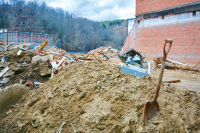All hands on deck: New program trains hiking club members to assist SAR missions
 Trainees get acclimated to the U.S. National Grid system the Search and Rescue crew uses for navigation. Nancy East photo
Trainees get acclimated to the U.S. National Grid system the Search and Rescue crew uses for navigation. Nancy East photo
When Chad Seger was reported missing on Friday, Oct. 16, 2020, the Haywood County Rescue Squad’s Wilderness Search and Rescue Team deployed immediately to seek the 27-year-old Asheville man in the Shining Rock Wilderness Area. But even with rescue crews from across the region joining the effort, day after day went by with no sign of Seger.
“All the regional teams were getting pretty tapped out, because it was during the week and all of us have to work outside of search and rescue,” said SAR team member Nancy East. “It’s just volunteer.”
It wasn’t until Tuesday, Oct. 20, that search teams located Seger’s body near the Art Loeb Trail — eight days after Seger last spoke to his family and four days after he was reported missing. SAR Director Mike Street saw how the search had strained the region’s volunteer resources and asked Steve Kuni, who is a member of both the SAR team and of the Carolina Mountain Club, to see if the hiking club might be interested in forging a partnership.
“His idea was to use experienced people in the woods from the local area that are not on the team and train them to a level where we wouldn’t expect them to do dangerous missions, night missions, searches and rescues involving ropes and whatnot — but if they can help us do the simple search of ‘look down this trail and see if you can find this person,’ that would help us a lot,” said Kuni.
CMC, which at 90 years is the oldest hiking and trail maintaining club in Western North Carolina, seemed the perfect place to look for those experienced, local woodspeople Street hoped to find. Kuni contacted CMC member Bill Sanderson and received an enthusiastic response — and the result is a brand-new partnership between the SAR team and CMC, training CMC members to assist the SAR team on longer missions like the search for Seger.
A retired army officer, Kuni moved to Haywood County with his wife about five years ago, and his involvement with both SAR and CMC began soon afterward. He signed up for the SAR team but needed to get in shape to be at his most effective on missions, so he started using local trails for exercise. On one of those workout hikes, he bumped into a CMC trail maintainer and started asking questions. He wanted to know how he could give back to the trails that had proved so important in his fitness journey. Eventually, he wound up as trail maintainer for the Buckeye Gap Trail in the Middle Prong Wilderness.
Related Items
As the bridge between the two organizations, Kuni was instrumental in developing what is still a new and semi-experimental program. Currently open only to CMC members, the program provides participants the basic training needed to ensure that they understand how to work under SAR leadership and that they’ll be an asset in the backcountry, not a liability.
“If you’re not prepared, it can turn bad real quick, and then we wind up having to rescue the rescuers,” said Kuni.

A Carolina Mountain Club member demonstrates fire-building skills during the training program. Nancy East photo
CMC members tend to be woods-savvy folks already, and the training process provides additional layers of knowledge. It includes an introductory briefing covering rules and regulations, communications procedures, responsibilities and authorities, as well as a skills training that covers improvised shelters and fire-building, first aid and navigation using the U.S. National Grid navigation system that search and rescue crews rely on. It’s different from the latitude and longitude system and unfamiliar to most people outside the SAR world.
Prospective trainees must also pass a pack test that requires them to travel 3 miles in 45 minutes while carrying 20 pounds.
“This is an actual demonstrable ability that we know they can move down a trail and not be a liability,” said Kuni.
The first aid section of the training ensures that team members can provide first aid to each other, said Kuni. CMC members are not supposed to administer first aid to subjects, but rather to connect them to a first responder as quickly as possible — with the caveat that they are permitted to react like a “reasonable person” in case of emergency.
“If the situation were such that they had no communication, conditions were deteriorating, I would expect them to use their common sense and say, ‘Yeah, we need to treat this guy and get him out of here,’” said Kuni. But in general, CMC partners are to leave medical treatment to the medical professionals.
So far, 16 CMC members are fully trained to assist the Haywood SAR team, and another four have volunteered to start the process. But so far, nobody has deployed.
“Most of our missions conclude in less than 12 hours,” said Kuni. “We might need these guys once or twice a year, but they all know that up front. If we do need them, then we really, really need them.”

CMC members go through basic swift water awareness training, which teaches them how to assist swiftwater technicians and how to react should they find themselves in a swiftwater situation. Donated photo
As of now, the program is open only to CMC members, most of whom live in Buncombe County but know Haywood’s trails intimately. It’s hard to say what its future might hold, though — whether training opportunities might open beyond CMC membership, or if the program will serve as a stepping stone toward full Haywood SAR membership. It’s a young program, and its leaders are still figuring out the details.
“We’re not building an airplane in flight, but we are building it from the ground floor up,” said Kuni.
The Haywood SAR team prefers that its members reside in Haywood County, so CMC’s Buncombe-centric membership is not the ideal pool for prospective new recruits. But the program has netted at least one so far — Sanderson is now a full member of the Wilderness Search and Rescue Team.
“He came to our meeting to see what was going on,” said Kuni. “He looked at the boss and said, ‘How do I join?’”
Do your part
Haywood County has one of the most organized and highly trained volunteer search and rescue teams around. Here’s how you can help this crew continue to fulfill its lifesaving mission.
-
Donate to the WNC Wilderness Safety Fund at wncwildernesssafety.org .
-
Join the team. Find out how at haywoodrescue.org/specialty-teams/sar .
-
Don’t become a rescue call. For tips on planning and packing appropriately, visit americanhiking.org/resources/planning-your-hike .









